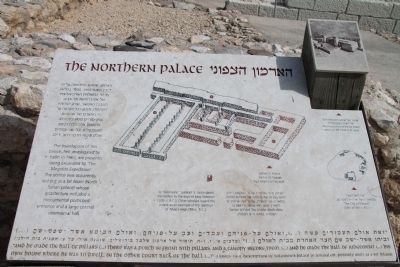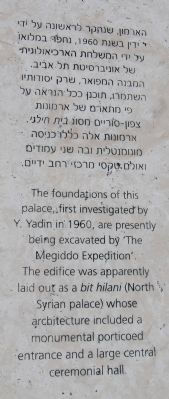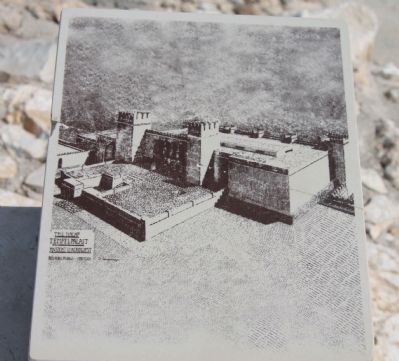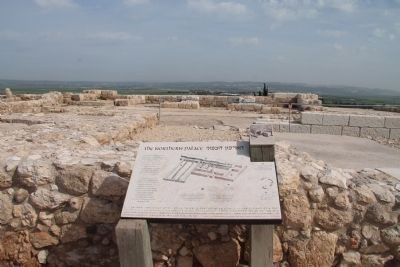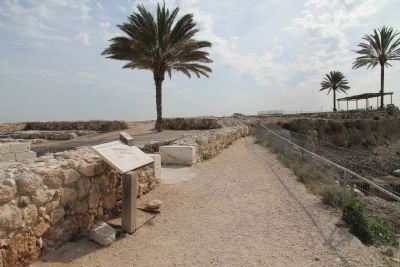Near Megiddo, Haifa District, Israel — West Asia (the Levant in the Middle East)
The Northern Palace
The foundations of this palace, first investigated by Y. Yadin in 1960, are presently being excavated by 'The Megiddo Expedition'. The edifice was apparently laid out as a bit hilani (North Syrian palace) whose architecture included a monumental porticoed entrance and a large central ceremonial hall.
[Text across the Bottom of the Marker]:
"And he made the hall of pillars (...) there was a porch in front with pillars, and a canopy before them. (...) and he made the hall of judgement (...) his own house where he was to dwell, in the other court back of the hall (...)" (I Kings 7: 6-8. Description of Solomon's palace in Jerusalem, possibly built as a bit hilani)
Topics and series. This historical marker is listed in these topic lists: Anthropology & Archaeology • Forts and Castles • Settlements & Settlers. In addition, it is included in the Tel Megiddo series list. A significant historical year for this entry is 1960.
Location. 32° 35.144′ N, 35° 11.107′ E. Marker is near Megiddo, Haifa District. Marker can be reached from National Route 66 just north of National Route 65, on the left when traveling north. This historical marker is located in the Megiddo National Park. The park is located between the Megiddo and Yokne‘am junctions (road no. 66), about 2 km west of the Megiddo junction. The historical marker is situated at the top of Tel Megiddo, on the north side, just beyond the marker for the northern stables. Touch for map. Touch for directions.
Other nearby markers. At least 8 other markers are within walking distance of this marker. The Northern Stables (a few steps from this marker); The Sacred Area (within shouting distance of this marker); A Unique Continuity (within shouting distance of this marker); From Megiddo to Armageddon (within shouting distance of this marker); Schumaker's Excavations (about 90 meters away, measured in a direct line); The City-Gate (about 90 meters away); Tel Megiddo National Park (about 90 meters away); a different marker also named The City-Gate (about 120 meters away). Touch for a list and map of all markers in Megiddo.
More about this marker. The "Megiddo National Park" handout/brochure has this to say about Stop 7, "The Northern Palace" on the historic tour:
Beneath the northern stable complex lay the remains of a square building featuring thick ashlar walls, dating to the Israelite period II. It is similar in size and character to the central building of the contemporaneous southern palace. Megiddo's excavators therefore assume it was also built in the center of a large square courtyard surrounded by walls or rooms. The precise plan is difficult to reconstruct; however,
its facade probably faced south with a row of rooms in the northern and western sides with plastered floors. Yigal Yadin suggested that the building was a palace from the time of King Solomon, based, among other things, on the descriptions of Solomon's impressive building projects in the book of 1 Kings. However, some scholars now date the palace to the time of King Ahab.
Regarding The Northern Palace. Although it does not state it on the text of this particular historical marker, the "Megiddo National Park" handout/brochure shares two different views on when the Northern Palace was built. These two different views are the result of the current split in scholars of Biblical archaeology and history into two camps identified as minimalists and maximalists. I have included two links to help the reader to understand what the significant issues are in these two differing views.
It should be noted that this debate in view points is focused on the period in Ancient Near History from about 1,000 to 800 B.C. (the time period that this historical marker's city-gate falls into) and that the debate is centered around matching the historical timeline of the literature found in the text of the Bible with the historical timeline of the archaeological evidence being found in the lands and physical sites associated with the Bible.
The
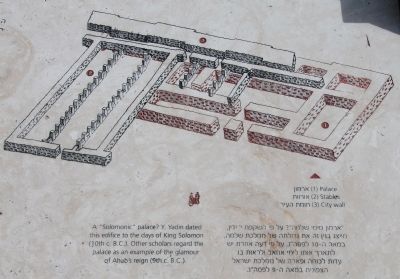
Photographed By Dale K. Benington, March 8, 2013
3. The Northern Palace Marker
Close-up view of the illustration of the Northern Palace displayed on the historic marker. The listed numbered items are as follows: 1) Stables, 2) Palace, 3) City wall. The caption under the picture reads: A "Solomonic" palace? Y. Yadin dated this edifice to the days of King Solomon (10th c. B.C.). Other scholars regard the palace as an example of the glamour of Ahab's reign (9th c. B.C.).
The author of the other link (who is pro maximalist) writes, "According to the minimalists, the United Monarchy never split into two kingdoms, Judah and Israel, because it never existed in united form in the first place. Their account is that the two kingdoms developed side by side, with the Kingdom of Judah and its capital, Jerusalem, developing at a far later stage, after the consolidation of the Kingdom of Israel in the ninth and eighth centuries BCE. In this interpretation, David and Solomon are entirely fictional figures."
Related markers.
Click here for a list of markers that are related to this marker. To better understand the relationship, study each marker in the order shown.
Also see . . .
1. Tel Megiddo. This is a link to information provided by Wikipedia, the free encyclopedia. (Submitted on April 30, 2013, by Dale K. Benington of Toledo, Ohio.)
2. The Megiddo Expedition. This is a link to information provided by The Megiddo Expedition Website. (Submitted on April 30, 2013, by Dale K. Benington of Toledo, Ohio.)
3. Tell Megiddo. This is a link to information provided by the BibleWalks.com website. (Submitted on April 30, 2013, by Dale K. Benington of Toledo, Ohio.)
4. Bit-hilani. This is a link to information provided by Wikipedia, the free encyclopedia. (Submitted on April 30, 2013, by Dale K. Benington of Toledo, Ohio.)
Credits. This page was last revised on December 14, 2023. It was originally submitted on April 30, 2013, by Dale K. Benington of Toledo, Ohio. This page has been viewed 915 times since then and 34 times this year. Photos: 1, 2, 3, 4, 5, 6. submitted on April 30, 2013, by Dale K. Benington of Toledo, Ohio.
